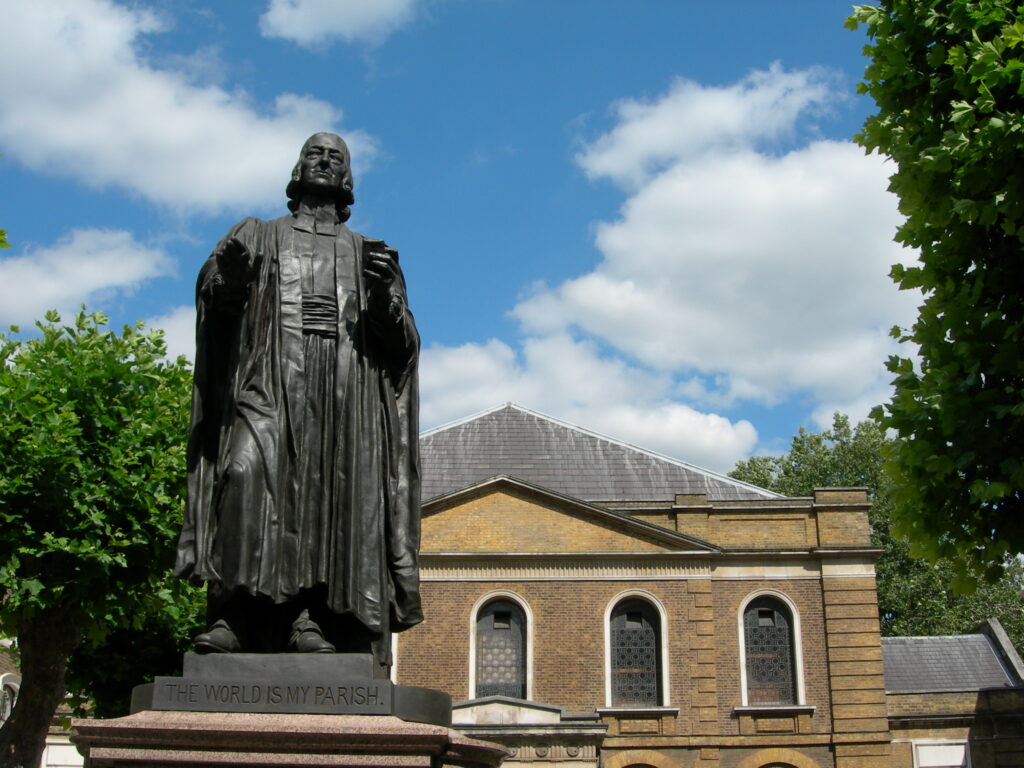Our Wesleyan Theology
What a marvelous thought! And that is but the first line of the hymn. In Jesus, God became incarnate and acted decisively to reconcile the world to himself (John 3:15-16; Romans 1:1-16). While we were still sinners, God offered His own Son “as a sacrifice of atonement” for sin (Romans 3:25). The Lord of all creation took on himself the sin of the world and provided salvation for us all!
In Christ Jesus, the righteousness of God—His salvation—was disclosed (Romans 3:21). Were it not for this action, all humankind would be hopelessly alienated from God (Ephesians 1:5-2:10). As it is, all the powers that would separate us from God have been defeated (Colossians 2:15). Now, “through faith in Jesus Christ” (Romans 3:22), we are set free (Romans 8:2)!
The New Testament forms one continuous hymn of praise to the God who lavishes His riches upon us (Ephesians 1:6-10). In Christ all the fullness of God dwelt bodily, and those who receive Christ will come to fullness in Him (Colossians 2:8-15). After examining the benefits of God’s grace, Paul exclaimed, “Oh, the depth of the riches of the wisdom and knowledge of God!” (Romans 11:33). Some of those riches can be identified: forgiveness of sin, the Spirit dwelling in us, formation in Christ’s image, eternal life, peace with God, sanctification, the fellowship of the Church, and hope for the Lord’s return.
When Jesus spoke, what many people heard was indeed “good news,” namely, that God freely reconciles sinners to himself. Even a hated tax collector or a woman caught in adultery, hearing of God’s love, can repent, be forgiven and receive eternal life. God gives himself freely to those who acknowledge their own inability to do anything that would merit His favor (Luke 15).
Long before we become aware of it, the Holy Spirit is at work, attempting to draw us to salvation. The psalmist says there is no place where the voice of God is not heard (Psalm 19:3). Paul tells us that, moment by moment, the whole creation depends upon Christ for its existence (Colossians 1:15-17). John declares that Christ enlightens everyone (John 1:9).
In ways matched only by the creativity and faithfulness of God, the Holy Spirit works in both individual and social histories to open pathways for the gospel. He goes before the explicit proclamation of the Gospel and prepares persons to hear—and hopefully receive—the Good News.
In retrospect, all Christians can trace a pattern by which the Spirit brought them to Christian redemption. We refer to this preparatory dimension of God’s grace as “prevenient grace,” or the grace that goes before.
God is for us. Everything that God accomplished through His Son, He now offers to us through the Holy Spirit. Indeed, the whole creation benefits from the salvation that the Father accomplished in His Son (Romans 8:19-25).
Justification is the name we give to the gracious act by which God actually forgives and reconciles sinners to himself. Justification—being returned to God’s favor—is by grace through faith alone.
Justification is but one dimension of God’s saving work. A second benefit is that the Spirit of God actually indwells the repentant sinner to establish the life of God. He or she is born anew— regenerated—by the Spirit of God. The New Testament calls this new realization of spiritual life a new creation, a new birth, birth from above, eternal life, entrance into the kingdom of God, walking in newness of life, and life in the Spirit.
Whatever the language, by the miracle of divine grace, the Holy Spirit actually takes up residence in the Christian and effects a transformation. Where once there was death, now there is life; peace with God where once there was warfare; hope where once there was despair. The New Testament nnounces: “If anyone is in Christ, he is a new creation; the old has gone, the new has come! All this is from God” (2 Corinthians 5:17-18a).
The New Testament speaks of Christians as being “in Christ” and of Christ as being in them. On the one hand, Christians are now reconciled to God because by faith they are “in Christ” (Romans 8:1), in him who reconciles repentant sinners to the Father.
But the New Testament also speaks of Christ in us as “the hope of glory” (Colossians 1:27). Through the Holy Spirit, the resurrected Christ imparts His life—himself—in His people. He abides in them and cultivates within them the fruit of the Spirit (Galatians 5:22-23).
“But,” many ask, “realistically, what kind of spiritual life can I expect as a Christian? Will not the pull of old sinful habits still set the pattern for my life? Or, does the Spirit of God now within me offer a better life?” The New Testament answers: “The one who is in you is greater than the one who is in the world” (1 John 4:4).
The same power that raised Jesus Christ from the dead—making him Victor over death, hell, sin and the grave—now works in us by the Holy Spirit (Ephesians 1:19)! Once the old law of sin and death ruled. But now “through Christ Jesus the law of the Spirit of life set me free from the law of sin and death” (Romans 8:2).
The joyous norm for all Christians is that they be filled with Holy Spirit, that they live not according to the flesh but according to the Spirit (Romans 8:1-8). Have you personally experienced in your life the miracle of God’s transforming grace?
“The Miracle of Transforming Grace” essay taken from, The Reflecting God Study Bible® 2000. Bible copyright by The Zondervan Corporation and Essay by Beacon Hill Press of Kansas City. Used by permission of Publisher. All rights reserved.
For more information, please visit: http://nazarene.org/sites/default/files/essentials/docs/Our%20Wesleyan%20Theology-en%201.1.pdf


